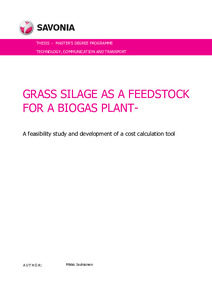Grass Silage as a Feedstock for a Biogas Plant: a feasibility study and development of a cost calculation tool
Jauhiainen, Mikko (2022)
Jauhiainen, Mikko
2022
All rights reserved. This publication is copyrighted. You may download, display and print it for Your own personal use. Commercial use is prohibited.
Julkaisun pysyvä osoite on
https://urn.fi/URN:NBN:fi:amk-2022121930796
https://urn.fi/URN:NBN:fi:amk-2022121930796
Tiivistelmä
Abstract
This study was commissioned by Envitecpolis Oy to investigate the cost structure of grass silage used as feedstock for a biogas plant in order to determine the factors affecting it, and to assess its profitability from the biogas plant and the producer's point of view.
Three different types of harvesting chains were included in the study, which were assumed to be suitable for different situations. The input data and calculation criteria for the calculator were based on a literature review, on time consumption analysis carried out between 2021 and 2022, actual costs incurred at the time, as well as on the available statistical costs of contracting.
During the study, an Excel-based calculation tool was developed. The calculator could be used to calculate feedstock production costs in terms of yield, transporting distance, and the average field size. The calculator was used to examine the production costs in general, and in two separately defined cases; one for a farm-scale wet digester with a procurement radius of about 15 km, and one for an industrial-scale dry digester with a procurement radius of about 50 km. In the future, the same calculation tool can be utilized to estimate the costs of feedstock procurement, e.g., in the pre-feasibility phase of a biogas plant project.
In the study it was found out that if used for the feedstock, the production cost of grass silage is a significant factor in the total cost of biogas production. Due to the high production costs (so-called plant price) from an inefficient supply chain, grass silage may not be a viable feedstock for the biogas process. But if organized efficiently, grass feed can be used to produce biomethane profitably. However, profitability demands high efficiency in the supply chain and that the sustainability criteria targets are met.
The most important factors affecting production costs are the yield per hectare and the moisture content of the material. The size of the field also had a significant impact on the cost and varied considerably between the harvesting chains. Bale-based chains were better suited for smaller fields and lower yields, but forage harvester-chain provided the lowest costs in case the average field size was over 1.5 ha. At its lowest, the plant cost of the grass feedstock was around 100 € /t-DM (~30 €/MWh-CH4). As the yield levels dropped, or another harvest efficiency variable was unfavorable, the production cost quickly reached 200 €/t-DM (~60 €/MWh-CH4), a level that could be considered approximately the upper limit of profitability at the current biomethane selling prices.
This study was commissioned by Envitecpolis Oy to investigate the cost structure of grass silage used as feedstock for a biogas plant in order to determine the factors affecting it, and to assess its profitability from the biogas plant and the producer's point of view.
Three different types of harvesting chains were included in the study, which were assumed to be suitable for different situations. The input data and calculation criteria for the calculator were based on a literature review, on time consumption analysis carried out between 2021 and 2022, actual costs incurred at the time, as well as on the available statistical costs of contracting.
During the study, an Excel-based calculation tool was developed. The calculator could be used to calculate feedstock production costs in terms of yield, transporting distance, and the average field size. The calculator was used to examine the production costs in general, and in two separately defined cases; one for a farm-scale wet digester with a procurement radius of about 15 km, and one for an industrial-scale dry digester with a procurement radius of about 50 km. In the future, the same calculation tool can be utilized to estimate the costs of feedstock procurement, e.g., in the pre-feasibility phase of a biogas plant project.
In the study it was found out that if used for the feedstock, the production cost of grass silage is a significant factor in the total cost of biogas production. Due to the high production costs (so-called plant price) from an inefficient supply chain, grass silage may not be a viable feedstock for the biogas process. But if organized efficiently, grass feed can be used to produce biomethane profitably. However, profitability demands high efficiency in the supply chain and that the sustainability criteria targets are met.
The most important factors affecting production costs are the yield per hectare and the moisture content of the material. The size of the field also had a significant impact on the cost and varied considerably between the harvesting chains. Bale-based chains were better suited for smaller fields and lower yields, but forage harvester-chain provided the lowest costs in case the average field size was over 1.5 ha. At its lowest, the plant cost of the grass feedstock was around 100 € /t-DM (~30 €/MWh-CH4). As the yield levels dropped, or another harvest efficiency variable was unfavorable, the production cost quickly reached 200 €/t-DM (~60 €/MWh-CH4), a level that could be considered approximately the upper limit of profitability at the current biomethane selling prices.
